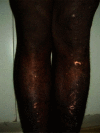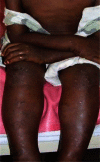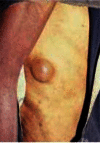Rapid epidemiological assessment of onchocerciasis in a tropical semi-urban community, enugu state, Nigeria
- PMID: 23682272
- PMCID: PMC3655252
Rapid epidemiological assessment of onchocerciasis in a tropical semi-urban community, enugu state, Nigeria
Abstract
Background: This study was carried out in Opi-Agu a tropical semi-urban autonomous community comprising of three villages in Enugu State, Nigeria, between the months of April and June 2010. It was designed to determine the prevalence of Onchocerca volvulus infection and assess the perception of the disease among the inhabitants of this community.
Methods: A total number of 305 individuals comprising of 148 males and 157 females were examined for various manifestations of onchocerciasis symptoms using rapid epidemiological assessment (REA) method.
Results: Out of this number, 119 (39.02%) individuals were infected. Prevalence of infection among age groups and villages varied. Age group 41 yr and above had the highest (31.00%) prevalence, while among the villages, Ogbozalla village ranked higher (45.71%) than the other villages. Overall the prevalence of infection among the sexes revealed that males were more infected (43.24%) than the females (35.03%). Lichenified onchodermatitis (LOD) was the most prevalent (35.29%) onchocerciasis symptom among others identified in the area, while leopard skin (LS) had the lowest (20.17%) occurrence and blindness (0.00%) which is the most devastating effect of O. volvulus infection was not observed. Questionnaire responses from 410 individuals revealed that 34.8% respondent from Idi village and 28.1% from Ibeku village believed that O. volvulus infection occurs through poor personal hygiene. Bite of blackfly ranked least (10.6%) among the respondent's knowledge of the causes of onchocerciasis in Opi-Agu community.
Conclusion: Opi-Agu community members had poor knowledge of onchocerciasis, the vector and of its etiologic organism. There is need for integration of community health education with mass chemotherapy.
Keywords: Nigeria; Onchocerca volvulus; Onchocerciasis; Prevalence; River blindness.
Figures





Similar articles
-
A community-based cross-sectional study of the epidemiology of onchocerciasis in unmapped villages for community directed treatment with ivermectin in Jimma Zone, southwestern Ethiopia.BMC Public Health. 2015 Jul 1;15:595. doi: 10.1186/s12889-015-1888-x. BMC Public Health. 2015. PMID: 26130117 Free PMC article.
-
Eye lesions, blindness and visual impairment in the Taraba river valley, Nigeria and their relation to onchocercal microfilariae in skin.Acta Trop. 1992 Jun;51(2):143-9. doi: 10.1016/0001-706x(92)90056-4. Acta Trop. 1992. PMID: 1354932
-
High prevalence of epilepsy in two rural onchocerciasis endemic villages in the Mahenge area, Tanzania, after 20 years of community directed treatment with ivermectin.Infect Dis Poverty. 2018 Jun 20;7(1):64. doi: 10.1186/s40249-018-0450-3. Infect Dis Poverty. 2018. PMID: 29921319 Free PMC article.
-
Mapping the burden of onchocercal skin disease.Br J Dermatol. 2021 Feb;184(2):199-207. doi: 10.1111/bjd.19143. Epub 2020 Jun 21. Br J Dermatol. 2021. PMID: 32302410 Review.
-
Neurological manifestations in Onchocerca volvulus infection: A review.Brain Res Bull. 2019 Feb;145:39-44. doi: 10.1016/j.brainresbull.2018.08.024. Epub 2018 Nov 17. Brain Res Bull. 2019. PMID: 30458251 Free PMC article. Review.
Cited by
-
Onchodermatitis: Where Are We Now?Trop Med Infect Dis. 2018 Sep 1;3(3):94. doi: 10.3390/tropicalmed3030094. Trop Med Infect Dis. 2018. PMID: 30274490 Free PMC article. Review.
-
Socio-cultural factors in onchocerciasis control: a study of rural Southeast Nigeria.J Parasit Dis. 2021 Mar;45(1):10-16. doi: 10.1007/s12639-020-01269-7. Epub 2020 Sep 10. J Parasit Dis. 2021. PMID: 33746381 Free PMC article.
-
[Knowledge, attitudes and practices of the population of SAMBWA health area in relation to the treatment of onchocerciasis with ivermectin under community directives].Pan Afr Med J. 2014 Dec 8;19:356. doi: 10.11604/pamj.2014.19.356.5575. eCollection 2014. Pan Afr Med J. 2014. PMID: 25932069 Free PMC article. French.
-
Persistence of onchocerciasis in villages in Enugu and Ogun states in Nigeria following many rounds of mass distribution of ivermectin.BMC Infect Dis. 2022 Nov 10;22(1):832. doi: 10.1186/s12879-022-07811-7. BMC Infect Dis. 2022. PMID: 36357828 Free PMC article.
References
-
- Schiller EL. Onchocerciasis vector biology control (VBC) Trop Dis Pap. 1990;3:1–25.
-
- Opara KN, Usip LP, Akpabio EE. Transmission dynamics of Simulium damnosum rural communities of Akwa Ibom State, Nigeria. J Vector Borne Dis. 2008;45:225–30. - PubMed
-
- WHO. WHO Tech Rep Ser. 1995. Onchocerciasis and its control. Report of a World Health Organization Expert Committee on onchocerciasis control; pp. 1–852. - PubMed
-
- Okulicz JF, Stibich AS, SDirk A, Elston M, Schwartz RA. Cutaneous onchocercoma. Inter J Dermatol. 2004;43:170–2. - PubMed
-
- WHO. Geneva: 2008. Status of onchocerciasis in APOC countries. TDR/AFR/RP/951.
LinkOut - more resources
Full Text Sources
Miscellaneous
